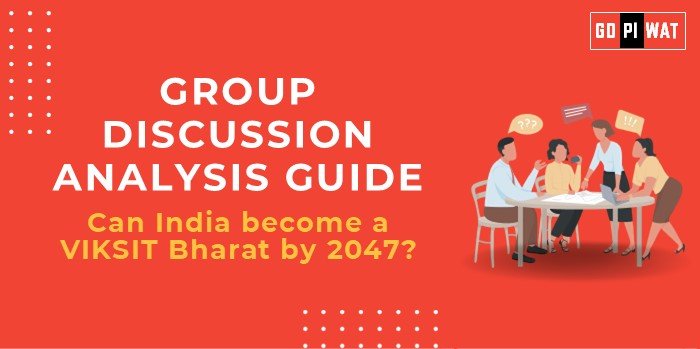📋 Can India become a VIKSIT Bharat by 2047?
🌐 Introduction
Opening Context: “India’s ambitious vision of becoming a VIKSIT Bharat (Developed Nation) by 2047 aligns with the centenary of its independence, representing a pivotal moment to evaluate its progress in economic, technological, and social domains.”
Background: This vision stems from aspirations laid out in the Amrit Kaal agenda, emphasizing inclusive development, technological adoption, and global competitiveness. Critical to this is sustained economic growth, addressing inequalities, and leveraging India’s demographic dividend.
📊 Quick Facts and Key Statistics
- 📈 Economic Growth: India’s GDP is projected to reach $6 trillion by 2029, positioning it as the world’s third-largest economy.
- 🌐 Digital Expansion: As of January 2024, India had 751.5 million internet users, with an internet penetration rate of 52.4%.
- 👨👩👧👦 Demographics: Over 50% of India’s population is under 30 years old, providing a substantial demographic dividend.
- 🌞 Renewable Energy: India aims to achieve 50% renewable energy capacity by 2040, contributing to sustainable development.
🔗 Stakeholders and Their Roles
- 🏛️ Government of India: Formulates policies, invests in infrastructure, and manages fiscal strategies to drive development.
- 🏢 Private Sector: Invests in technology, manufacturing, and skill development, fostering innovation and economic growth.
- 👥 Citizens: Engage in digital adoption, skill enhancement, and entrepreneurship, contributing to the nation’s progress.
- 🌍 Global Partners: Provide foreign direct investment, technology transfers, and trade partnerships, supporting India’s development goals.
- 📚 NGOs: Address gaps in education, healthcare, and rural empowerment, promoting inclusive growth.
✅ Achievements and 🚩 Challenges
✅ Achievements:
- 📈 Economic Growth: India’s GDP grew by 6.7% year-on-year in the April-June quarter of 2024, outpacing major economies.
- 📱 Digital Transformation: The country has witnessed a surge in digital payments, with 11.5 billion UPI transactions per month as of March 2024.
- 🚧 Infrastructure Development: Initiatives like Bharatmala and Sagarmala have enhanced connectivity and trade.
- 🚀 Startup Ecosystem: India is home to over 100 unicorns, with a combined valuation exceeding $340 billion.
🚩 Challenges:
- ⚖️ Income Inequality: The urban-rural divide remains significant, affecting equitable growth.
- 🌪️ Climate Vulnerabilities: India faces increasing environmental risks and natural disasters.
- ⚙️ Global Competitiveness: Enhancing manufacturing and research capabilities is essential to remain competitive.
🌏 Global Comparisons and 📚 Case Studies
Global Comparisons:
- 🌉 China: Massive infrastructure investments and export-driven growth have propelled its development.
- 🏭 Germany: A model for vocational training and industrial innovation, contributing to its developed status.
Case Studies:
- 🏥 Kerala Model: Notable for exceptional progress in health and education indices.
- 🏗️ Gujarat’s Industrial Policy: Driving state-led economic transformation through robust industrial policies.
💬 Structured Arguments for Discussion
- Supporting Stance: “India’s robust economic growth and digital advancements position it favorably to achieve the Viksit Bharat vision by 2047.”
- Opposing Stance: “Persistent challenges such as income inequality and climate vulnerabilities may impede India’s progress toward becoming a developed nation by 2047.”
- Balanced Perspective: “While India has made significant strides in economic and digital sectors, addressing structural challenges is crucial to realizing the Viksit Bharat vision by 2047.”
💡 Effective Discussion Approaches
- 🧑🎓 Opening Approaches:
- “With over 50% of its population under 30, India possesses a demographic advantage that could drive its development goals.”
- “Comparing India’s development strategies with those of China and Germany offers valuable insights into potential pathways to becoming a developed nation.”
- 🔄 Counter-Argument Handling:
- “While India’s digital economy is booming, the digital divide between urban and rural areas remains a significant hurdle.”
- “Implementing targeted policies to enhance rural connectivity and digital literacy can bridge this gap.”
📌 Strategic Analysis of Strengths and Weaknesses
🌟 Strengths:
- 👨👩👧👦 Demographic Dividend: A young and dynamic workforce.
- 📱 Digital Ecosystem: Rapid adoption of digital technologies.
- 🌍 International Trade Potential: Expanding global trade partnerships.
❌ Weaknesses:
- ⚖️ Income Inequality: Significant disparities between different population segments.
- 🚧 Infrastructure Gaps: Need for improved infrastructure in rural areas.
- 🌪️ Climate Risks: Vulnerability to environmental challenges.
🚀 Opportunities:
- 🌞 Renewable Energy Leadership: Potential to lead in sustainable energy solutions.
- 🤝 Global Partnerships: Opportunities for international collaborations.
⚠️ Threats:
- 🌍 Geopolitical Tensions: Potential impacts on economic stability.
- 📉 Economic Volatility: Risks associated with global economic fluctuations.
📚 Connecting with B-School Applications
- 🛠️ Real-World Applications: Public-private partnerships, project management in infrastructure, and digital innovation are critical areas for B-school projects.
- 🎓 Sample Interview Questions:
- “What policies should India prioritize to achieve Viksit Bharat by 2047?”
- “How can India balance economic growth with sustainability goals?”
- 🔍 Insights for Students: Emphasize the importance of inclusivity and sustainability in strategic projects, considering the diverse challenges and opportunities in India’s development journey.


